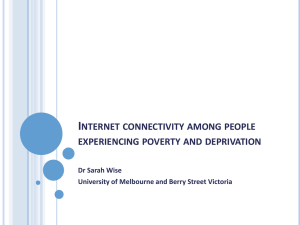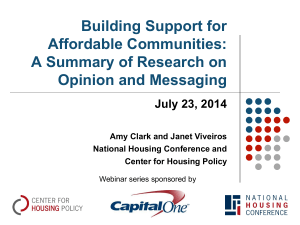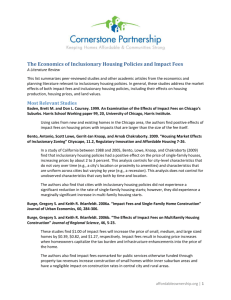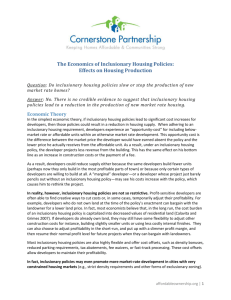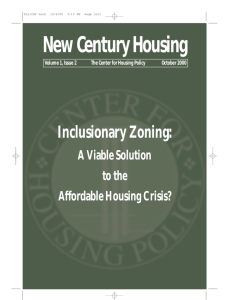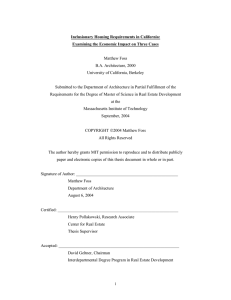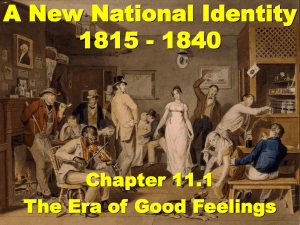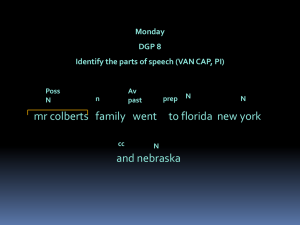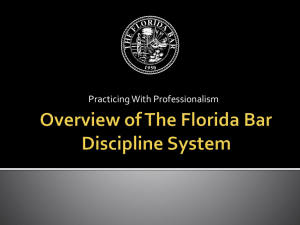Land Use Tools to Promote Inclusion
advertisement
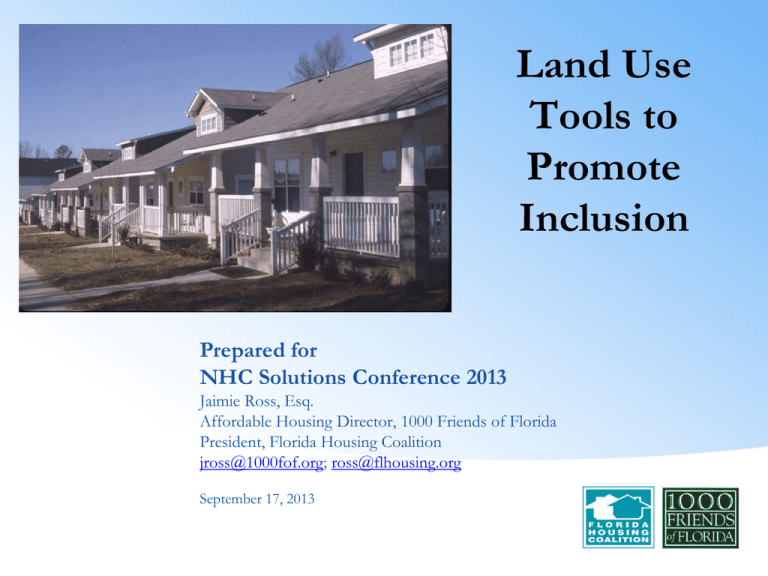
Land Use Tools to Promote Inclusion Prepared for NHC Solutions Conference 2013 Jaimie Ross, Esq. Affordable Housing Director, 1000 Friends of Florida President, Florida Housing Coalition jross@1000fof.org; ross@flhousing.org September 17, 2013 Government’s Role in Land Use • To promote public health, safety, and welfare • To be a good steward of the land for current and future generations • To balance private property rights with public interests 3 Tools for Creating and Preserving Affordable Homes • Inclusionary zoning; • Community land trusts; • Accessory dwelling units Inclusionary Zoning An optimal tool for affirmatively furthering fair housing Mitigate effects of traditional exclusionary zoning practices Community Land Trusts An optimal tool for inclusionary zoning success for homeownership or rental. CLTs can provide stewardship and administrative oversight for inclusionary units and land banks Accessory Dwelling Units An optimal tool for using existing infrastructure to create highly affordable rental homes Inclusionary Housing • Land use regulation that relies upon the private sector to produce affordable housing. • Requires that a certain percentage of new or redeveloped housing be affordable. • What is Affordable? • Inclusionary Housing policy creates housing choice for low income peoplereduces segregation. • Housing Policy is School Policy. • Inclusionary Housing is as much about “where” affordable housing is located as it is about producing affordable housing. Theory Behind Mandatory Inclusion of Affordable Housing • Affordable Housing is necessary for a healthy economy and sustainable community • Government land use authority increases the value of private land (land value recapture) • Affordable housing is the public benefit that is provided in exchange for development benefits such as up-zoning or form based zoning • Affordable Housing is a public facility- example Town of Davidson, North Carolina When is Inclusionary Policy the Right Policy? • When real estate market is not producing affordable housing • When there is a change in land use that increases the value of the property • Large Scale Developments- PUDs, DRIs, • New Urbanism (TND) Developments How it Works • A threshold number of market rate units that activates the inclusionary requirement; • Comparable in quality and aesthetics to the market rate units, so that even if they are smaller or of a different type (e.g. town home rather than single family home), they will blend into the community; • Benefits or incentives (if not tied to zoning change); • Affordability period. One of the most critical elements in an inclusionary housing ordinance is the term of affordability. When an affordable product is included in an otherwise unaffordable area, appreciation inflates at a substantially greater rate. Once a local government has adopted and implemented an inclusionary housing ordinance, it is imperative that a long term period of affordability accompany the development of the unit. • Policies for administration of the program and an opportunity for the developer to appeal the application of the ordinance to a particular project. Montgomery County, MD Housing Experience Inclusionary Housing got its most significant start in the United States with Montgomery County’s Moderately Priced Dwelling Unit Program. One of the most progressive features of Montgomery County’s policy is that they direct the Housing Opportunities Commission (pubic housing authority) to purchase or rent one-third of the MPDUs in order to extend housing assistance to working families far below the 65% of Area Median Income price point. Private, for-profit homebuilders have delivered 12,500+ “MPDUs” integrated into market rate developments of about 90,000 units. Inclusionary Housing Policies Should Result In: • • • • Location of affordable housing in areas of opportunity, Near employment; Transportation; and Integrated schools Caveat: Most real property laws are State specific • The 2001 Florida Legislature carved out an exception to the price and rent control statutes for land use mechanisms used to increase the supply of affordable housing, specifically citing “inclusionary housing ordinances”. • Section 166.0415 Affordable housing.–Notwithstanding any other provision of law, a municipality may adopt and maintain in effect any law, ordinance, rule, or other measure that is adopted for the purpose of increasing the supply of affordable housing using land use mechanisms such as inclusionary housing ordinances. • Section 125.01055 Affordable housing.–Notwithstanding any other provision of law, a county may adopt and maintain in effect any law, ordinance, rule, or other measure that is adopted for the purpose of increasing the supply of affordable housing using land use mechanisms such as inclusionary housing ordinances. Affordable Housing • Is a principle of New Urbanism • Yet, with the exception of HOPE VI redevelopments, virtually none of the more than 55 new urbanism developments in Florida provide affordable units • Florida is the “poster child” for the need to require that New Urbanism communities include long term or permanent affordable housing Seaside, Florida – the Original New Urbanism Community . • The “employee cottages”- would become homes for millionaires Bradenton Village, HOPE VI Baldwin Park, Orlando When there is no inclusionary requirement, we find that new urbanism developments typically fail to include homes for low income populations. City Place, West Palm Beach City Place, West Palm Beach Best Practices • Keep the Developer Economically Whole • Density by Right • Do not use payment in lieu as a “back- door impact fee”- and better not to use at all • Partnership effort with local government • Flexibility • Long term or perpetual affordability- dovetails with Community Land Trusts Why Use a Community Land Trust for Inclusionary Housing? • Avoid windfall to a particular family upon resale • Create a permanent stock of affordable housing • Insulate the private sector from administration of long term controls How Does a CLT Work? Tax exempt nonprofit organization (CLT) deeds the improvements (the home) to the home buyer together with a 99 year ground lease for the land. Two key provisions in the long term ground lease: • resale is limited to income eligible household; • resale price is limited to keep the house affordable to the next buyer (fair but not a market rate return) Key Benefits for the Homebuyer: • Price of the home is now affordable • Staying in the community without being a renter means: instead of rent payments, now make mortgage payments - return of equity upon resale mortgage interest payments are deductible financial stability-able to save without fear of rent increases or loss of housing (e.g. condo conversions) Key Benefits for the Public: • Public Investment is retained • Permanent stock of affordable housing is created Davidson, North Carolina • New Code requires 50% open space • 12% affordability for all new development • Justification- 12% of all Town’s housing was affordable at time of code change • Public interest- to not fall below existing affordable housing stock The Bungalows Davidson, NC Bungalows: Davidson Triplex designed to look like single family house Key to the Success of Community Land Trusts is: • Partnership and support of the local government • Donation of land to the CLT • A highly functioning nonprofit with the ability to provide a pipeline of qualified homebuyers • A fully informed and engaged community of prospective home buyers; homebuyer counseling • A fully informed and engaged lending community The Florida Community Land Trust Institute worked on legislation to address the property tax issue by providing statutory direction to the property appraisers to recognize the resale formula price as a land use restriction for purposes of tax assessment. It finally passed in the 2009 Session- new law F.S. 193.018 Connection between Form Based Zoning and Inclusionary Housing • Form based zoning – codifies new urbanism • An inclusionary housing requirement needs to be included within the form based zone if no inclusionary housing law is already enacted • In jurisdictions with IZ requirements, the codification of the form based zone should address the IZ ordinance- as the developer benefits within the form based code may need to be reconciled with the benefits in the IZ ordinance. Accessory Dwelling Units • Smart growth tool to create rental homes for extremely low income persons; • Uses existing infrastructure; • Within, outside, attached, detached; • Local considerations/restrictions; • Affordability for homeowner and renter Land Use Mechanisms • No single tool is the answer for all affordable housing needs• For example, Accessory Dwelling Units provide much needed rental for extremely low income populations; community land trusts provide homeownership for people with higher income but not high enough for market rate housing; inclusionary housing can meet all affordable market segments • Gentrification without Displacement requires long term Affordability • Community Land Trusts are a great vehicle for managing perpetual affordability • To reach very low, and extremely low income populations additional subsidy is needed. Federal funds, state funds, local funds. National Center for Economic Justice 727 15th Street NW Washington , D.C. 20005 Email: housinginfo@ihibalto.org Website: www.inhousing.org IHI is available to help local governments and developers design inclusionary and mixed income housing programs Jaimie Ross, Esq. Affordable Housing Director, 1000 Friends of Florida President, Florida Housing Coalition Email: jross@1000fof.org; ross@flhousing.org
